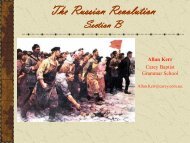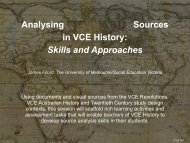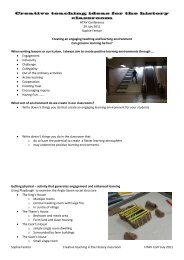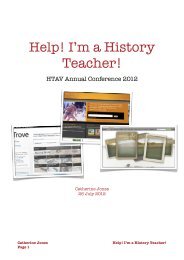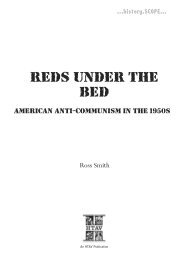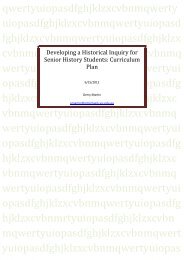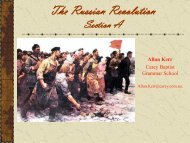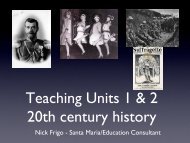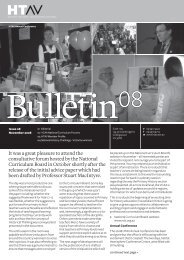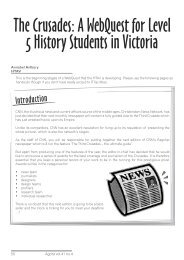Plotting Social Hierarchies in the Renaissance - HTAV
Plotting Social Hierarchies in the Renaissance - HTAV
Plotting Social Hierarchies in the Renaissance - HTAV
You also want an ePaper? Increase the reach of your titles
YUMPU automatically turns print PDFs into web optimized ePapers that Google loves.
<strong>Plott<strong>in</strong>g</strong> <strong>Social</strong><br />
<strong>Hierarchies</strong> <strong>in</strong><br />
<strong>the</strong><br />
<strong>Renaissance</strong><br />
City<br />
<strong>HTAV</strong> Annual Conference, 27 July 2012<br />
Emma.Nicholls@monash.edu
VCE Study Design<br />
Unit 4: <strong>Renaissance</strong> Italy<br />
Area of study 1: <strong>Social</strong> life <strong>in</strong> <strong>Renaissance</strong> Italy<br />
An <strong>in</strong>vestigation <strong>in</strong>to <strong>the</strong> diverse social life that existed <strong>in</strong> <strong>the</strong><br />
urban centres of Venice or Florence. An exam<strong>in</strong>ation of <strong>the</strong><br />
social structures of Venice or Florence as well as <strong>the</strong> social<br />
map. A select <strong>in</strong>vestigation of one area of social life: family,<br />
marriage, dowries, charity, social legislation and festivals.<br />
Particular groups might <strong>in</strong>clude: family, guilds, Scuola and<br />
confraternities, <strong>the</strong> poor as well as marg<strong>in</strong>alised groups<br />
<strong>in</strong>clud<strong>in</strong>g foreigners, prostitutes and homosexuals.
Centres and peripheries:<br />
a contemporary preoccupation too...
Structure of today’s lecture<br />
• What do we mean by ‘marg<strong>in</strong>alised’?<br />
• How might we beg<strong>in</strong> to plot <strong>the</strong> marg<strong>in</strong>alisation (or<br />
o<strong>the</strong>rwise) of some of <strong>the</strong>se groups socially and spatially?<br />
• How might ask<strong>in</strong>g questions about <strong>the</strong>se groups change our<br />
understand<strong>in</strong>g of <strong>the</strong> <strong>Renaissance</strong> as a whole?
Some ways of th<strong>in</strong>k<strong>in</strong>g<br />
about marg<strong>in</strong>alisation
R.I. Moore<br />
“Some years ago I asked <strong>in</strong> an exam<strong>in</strong>ation paper for schoolleavers,<br />
‘Why were heretics persecuted <strong>in</strong> <strong>the</strong> thirteenth century?’<br />
The question was very popular and <strong>the</strong> answer, with great<br />
confidence and near unanimity, ‘because <strong>the</strong>re were so many of<br />
<strong>the</strong>m.‟ – R.I. Moore, The Formation of a Persecut<strong>in</strong>g Society: Power and Deviance <strong>in</strong><br />
Western Europe, 950 – 1250. First published Basil Blackwell: Oxford,1987.<br />
• Argues aga<strong>in</strong>st <strong>the</strong> notion that difference is itself a<br />
cause for persecution.<br />
• Key po<strong>in</strong>t: Europe became a persecut<strong>in</strong>g society, it was<br />
not always so.<br />
• The persecution (or marg<strong>in</strong>alisation) of particular<br />
groups is not a natural, <strong>in</strong>evitable or universal<br />
condition. Ra<strong>the</strong>r, it is historically cont<strong>in</strong>gent.
The O<strong>the</strong>r <strong>Renaissance</strong><br />
• Alterity a major <strong>the</strong>me <strong>in</strong><br />
contemporary cultural<br />
<strong>the</strong>ory: e.g. Michel<br />
Foucault, Clifford Geertz,<br />
Edward Said, Homi K.<br />
Bhaba... and many o<strong>the</strong>rs<br />
Workshop of Agnolo Bronz<strong>in</strong>o, Portrait of Alessandro<br />
de’Medici, after 1553, Uffizi, Firenze.<br />
• As a field, medieval<br />
studies has tended to<br />
embrace <strong>the</strong>se<br />
approaches, whereas<br />
<strong>Renaissance</strong> studies has<br />
tended to be more<br />
resistant. Why?
Centre Stage: The Piazza
A contested space<br />
Domenico Ghirlandaio, Confirmation of <strong>the</strong> Rule,<br />
(detail), 1483-85, Santa Tr<strong>in</strong>ità, Florence.<br />
Giorgio Vasari, “Lorenzo de „Medici Accept<strong>in</strong>g<br />
Gifts from his Ambassadors,” Florence,<br />
Palazzo Vecchio, c. 1555.
More spectacles of dom<strong>in</strong>ion...<br />
Photo credit: croisbeauty at http://members.virtualtourist.com/m/p/m/113e26/
Who is miss<strong>in</strong>g?<br />
Who is at <strong>the</strong> periphery?
Women: A Conspicuous Absence<br />
“Women ... if <strong>the</strong>y be chaste, [are]<br />
locked up at home, as it were <strong>in</strong><br />
prison,” – Fynes Moryson, Scottish<br />
traveller, 16 th c.<br />
“All <strong>the</strong> young women (except <strong>the</strong><br />
ord<strong>in</strong>ary common whores) are kept<br />
with<strong>in</strong>... Few women walk <strong>the</strong> streets<br />
besides old bawds.” – Philip Skippon,<br />
17 th c.<br />
“I am not happy that you should stand<br />
at w<strong>in</strong>dows, <strong>in</strong> order to see who passes<br />
by...” - Archbishop Anton<strong>in</strong>us of<br />
Florence
Public Women, Women <strong>in</strong> <strong>the</strong> Streets<br />
• Constra<strong>in</strong>ts placed on patrician<br />
women tied to <strong>the</strong>ir pivotal role <strong>in</strong><br />
<strong>the</strong> marriage strategies of elite<br />
families. (See Christiane Klapisch-Zuber,<br />
Stanley Chojnacki.)<br />
• <strong>Renaissance</strong> street a place of<br />
violence<br />
• “I went alone for fun to see <strong>the</strong><br />
women who let <strong>the</strong>mselves be<br />
seen by anyone who wants... [<br />
<strong>the</strong>se women come to <strong>the</strong> doors<br />
of <strong>the</strong>ir houses, where <strong>the</strong>y stand<br />
<strong>in</strong> public view at convenient<br />
hours; and <strong>the</strong>re you see <strong>the</strong>m <strong>in</strong><br />
groups ... chatt<strong>in</strong>g and s<strong>in</strong>g<strong>in</strong>g <strong>in</strong><br />
<strong>the</strong> street.” – Michel de Montaigne on<br />
his visit to Florence’s prostitute’s quarter.
Two Venetian Ladies?<br />
“To become <strong>the</strong> prey of so many, at<br />
<strong>the</strong> risk of be<strong>in</strong>g despoiled,<br />
robbed, killed, ... exposed to so<br />
many o<strong>the</strong>r dangers of receiv<strong>in</strong>g<br />
<strong>in</strong>juries and dreadful contagious<br />
diseases, ... What riches, what<br />
comforts, what delights can<br />
possibly outweigh all this?<br />
Believe me, of all <strong>the</strong> world’s<br />
misfortunes, this is <strong>the</strong> worst.”<br />
- Veronica Franco (1456-91) on<br />
her life <strong>in</strong> prostitution<br />
Bottic<strong>in</strong>i, Two Venetian Ladies, 1510.
Sodomy<br />
• Michael Rocke’s major study of homosexuality and male<br />
sociability <strong>in</strong> Florence: an under-recognised but <strong>in</strong>tegral<br />
aspect of <strong>Renaissance</strong> society and culture.<br />
• In Florence, 2 <strong>in</strong> 3 men <strong>in</strong>crim<strong>in</strong>ated by <strong>the</strong> age of 40.<br />
• Important to note: “homosexual behaviour had little to<br />
do with current notions of sexual orientation or identity,<br />
but was organised around notions of gender and life<br />
stages.”<br />
• Manl<strong>in</strong>ess identified solely with a dom<strong>in</strong>ant role <strong>in</strong> sex.<br />
On <strong>Renaissance</strong> sexualities, see also: Guido Ruggiero,<br />
Judith Brown, Alan Bray, Eve Sedgwick, John Boswell.
Both Marg<strong>in</strong>alised and Integral<br />
“[Sexual debauchery has] ru<strong>in</strong>ed <strong>the</strong> world, ...<br />
corrupted men <strong>in</strong> lust, led women <strong>in</strong>to <strong>in</strong>decency,<br />
and boys <strong>in</strong>to sodomy and filth, and made <strong>the</strong>m<br />
like prostitutes... Young lads have been made<br />
<strong>in</strong>to women. But that‟s not all: fa<strong>the</strong>rs are like<br />
daughters, bro<strong>the</strong>rs like sisters. There‟s no<br />
dist<strong>in</strong>ction between <strong>the</strong> sexes or anyth<strong>in</strong>g else<br />
anymore.” – Girolamo Savonarola, 1496.<br />
Savonarola preach<strong>in</strong>g. Compendio di<br />
Revelatione, Florence,1496<br />
Dante, Inferno XV, Pisan manuscript, c.1345.
Decenter<strong>in</strong>g <strong>the</strong><br />
<strong>Renaissance</strong><br />
‣ How does th<strong>in</strong>k<strong>in</strong>g about marg<strong>in</strong>alised<br />
groups change our understand<strong>in</strong>g of <strong>the</strong><br />
<strong>Renaissance</strong> as a whole?
Did women have a <strong>Renaissance</strong>?<br />
Jacob Burckhardt, 1860:<br />
• In <strong>the</strong> <strong>Renaissance</strong>, “man became a spiritual <strong>in</strong>dividual, and<br />
recognized himself as such.” And fur<strong>the</strong>rmore, “…we must keep<br />
before our m<strong>in</strong>ds <strong>the</strong> fact that women stood on a foot<strong>in</strong>g of<br />
perfect equality with men. We must not suffer ourselves to be<br />
misled by <strong>the</strong> sophistical and often malicious talk about <strong>the</strong><br />
assumed <strong>in</strong>feriority of <strong>the</strong> female sex, which we meet with now<br />
and <strong>the</strong>n… There was no question of ‘woman’s rights’ or female<br />
emancipation, simply because <strong>the</strong> th<strong>in</strong>g itself was a matter of<br />
course. The educated woman, no less than <strong>the</strong> man, strove<br />
naturally after a characteristic and complete <strong>in</strong>dividuality.”<br />
Joan Kelly, 1977, ‘Did women have a <strong>Renaissance</strong>?’:<br />
• The economic and political developments “that reorganized<br />
society along modern l<strong>in</strong>es and opened <strong>the</strong> possibilities for <strong>the</strong><br />
social and cultural expression for which <strong>the</strong> age is known…<br />
affected women adversely, so much so that <strong>the</strong>re was no<br />
renaissance for women - at least not dur<strong>in</strong>g <strong>the</strong> <strong>Renaissance</strong>.”
The debate 35 years on…<br />
• Answer of course depends very much on how you<br />
def<strong>in</strong>e <strong>the</strong> <strong>Renaissance</strong>: this is a key po<strong>in</strong>t. Ask<strong>in</strong>g<br />
questions about gender forces us to qualify and<br />
reconsider what we mean when we talk about “<strong>the</strong><br />
<strong>Renaissance</strong>.”<br />
• 35 years later, new questions are be<strong>in</strong>g asked.<br />
• Leads us to look for different k<strong>in</strong>ds of sources.<br />
• Leads us to ask new questions of old sources.
Agency with<strong>in</strong> subjugation?<br />
• “… <strong>in</strong> practice, a woman might (and <strong>the</strong>se women all<br />
did) f<strong>in</strong>d some competition among <strong>the</strong> several<br />
authorities claim<strong>in</strong>g her duty – her own family, her<br />
husband, her k<strong>in</strong>g, her religion – as well as conflicts<br />
between her own desire and obedience to all of <strong>the</strong>se.<br />
This sets up, as Karl We<strong>in</strong>traub phrases it, a<br />
destabiliz<strong>in</strong>g competition among compell<strong>in</strong>g cultural<br />
forms; when <strong>the</strong> patriarchs do not l<strong>in</strong>e up neatly <strong>in</strong><br />
support of each o<strong>the</strong>r, women must choose, and <strong>the</strong>ir<br />
struggles to do so may serve as a catalyst for selfdef<strong>in</strong>ition,<br />
resistance, and writ<strong>in</strong>g.”<br />
- Barbara Kiefer Lewalski, “Writ<strong>in</strong>g Women and Read<strong>in</strong>g <strong>the</strong><br />
<strong>Renaissance</strong>.” <strong>Renaissance</strong> Quarterly 44, no. 4 (1991): 792 – 821.
Key po<strong>in</strong>ts<br />
• Marg<strong>in</strong>alisation has a history that we can<br />
study: it is not a timeless or universal given.<br />
• Ask<strong>in</strong>g questions about marg<strong>in</strong>alised groups<br />
has big implications for <strong>the</strong> way we<br />
understand <strong>the</strong> <strong>Renaissance</strong> as a whole.
Selected fur<strong>the</strong>r read<strong>in</strong>g<br />
• J. K. Brackett, “The Florent<strong>in</strong>e Onestà and <strong>the</strong> Control of Prostitution, 1403-1680,” The<br />
Sixteenth Century Journal 24, no. 2 (1993): 273-300.<br />
• J. Brown & R. Davis, eds, Gender and Society <strong>in</strong> <strong>Renaissance</strong> Italy, Longman, 1998.<br />
• R. Crum & J. Paoletti, eds, <strong>Renaissance</strong> Florence: A <strong>Social</strong> History, Cambridge University<br />
Press, 2006.<br />
• N. Debby, “Visual Rhetoric: Images of Saracens <strong>in</strong> Florent<strong>in</strong>e Churches,” Anuario de Estudios<br />
Medievales 42, no. 1 (2012): 7-28.<br />
• T. Earle & K. Lowe, Black Africans <strong>in</strong> <strong>Renaissance</strong> Europe, Cambridge University Press, 2005.<br />
• Y. Elet, “Seats of Power: The Outdoor Benches of Early Modern Florence,” Journal of <strong>the</strong><br />
Society of Architectural Historians 61, no. 4 (2002): 444-469.<br />
• Michael Jacoff, The Horses of San Marco and <strong>the</strong> Quadriga of <strong>the</strong> Lord, Pr<strong>in</strong>ceton University<br />
Press, 1993.<br />
• S. Milner, ed., At <strong>the</strong> Marg<strong>in</strong>s: M<strong>in</strong>ority Groups <strong>in</strong> Premodern Italy, University of M<strong>in</strong>nesota<br />
Press, 2005.<br />
• R.I. Moore, The Formation of a Persecut<strong>in</strong>g Society: Power and Deviance <strong>in</strong> Western Europe,<br />
950 – 1250. First published Basil Blackwell: Oxford, 1987.<br />
• M. Rocke, Forbidden Friendships: Homosexuality and Male Culture <strong>in</strong> <strong>Renaissance</strong> Florence,<br />
Oxford University Press, 1996.<br />
• J. Woolfson, Palgrave Advances <strong>in</strong> <strong>Renaissance</strong> Historiography, Palgrave MacMillan, 2005.
What do you th<strong>in</strong>k?<br />
• In what sense were ‘foreigners, prostitutes and<br />
homosexuals’ a marg<strong>in</strong>alised group?<br />
• Are <strong>the</strong>re o<strong>the</strong>rs you would <strong>in</strong>clude <strong>in</strong> this<br />
category?<br />
• How central are <strong>the</strong>se or o<strong>the</strong>r marg<strong>in</strong>alised<br />
groups to your own tell<strong>in</strong>g of <strong>Renaissance</strong><br />
history? How could <strong>the</strong>y become so?
In response to <strong>the</strong> questions and discussion after my lecture today, I hope you will f<strong>in</strong>d<br />
<strong>the</strong> follow<strong>in</strong>g resources of use <strong>in</strong> your teach<strong>in</strong>g and own read<strong>in</strong>g (websites with large<br />
primary source collections are on <strong>the</strong> next slide):<br />
• Cecilia Hewlett, Rural Communities <strong>in</strong> <strong>Renaissance</strong> Tuscany: Religious Identities and Local Loyalties, Brepols,<br />
2008.<br />
• Margaret L. K<strong>in</strong>g and Albert Rabil, eds, Her Immaculate Hand: Selected Works by and about <strong>the</strong> Women<br />
Humanists of Quattrocento Italy, Center for Medieval and Early <strong>Renaissance</strong> Studies, B<strong>in</strong>ghamton N. Y., 1983.<br />
• Mary Rogers and Paola T<strong>in</strong>agli, eds, Women <strong>in</strong> Italy, 1350-1650: Ideals and Realities: A Sourcebook,<br />
Manchester University Press, 2005. *An excellent collection of short, translated primary sources by and about women;<br />
good for students.<br />
• Nicholas Terpstra, Lost Girls: Sex and Death <strong>in</strong> <strong>Renaissance</strong> Florence, Johns Hopk<strong>in</strong>s University Press, 2010.<br />
• Richard C. Trexler, Power and Dependence <strong>in</strong> <strong>Renaissance</strong> Florence, Pegasus Press, 1998. Comprises three short,<br />
readable volumes: “ The Children of <strong>Renaissance</strong> Florence,” “The Women of <strong>Renaissance</strong> Florence,” “ The Workers of<br />
<strong>Renaissance</strong> Florence.” (Apologies, it was Trexler, not Terpstra who wrote <strong>the</strong>se little books.)
Websites<br />
• Eurodocs: Onl<strong>in</strong>e Sources for European History: http://eurodocs.lib.byu.edu<br />
• Early Modern Resources. http://earlymodernweb.org/<br />
• Internet Medieval Sourcebook. Full Text Sources: http://www.fordham.edu/halsall/sbook2.html<br />
• The Jane Fortune Project on Women Artists <strong>in</strong> <strong>the</strong> Age of <strong>the</strong> Medici. http://www.medici.org/jane-fortune-research-programwomen-artists-age-medici<br />
• Early Modern Women Onl<strong>in</strong>e. http://www.ssemw.org/zieglerlnks.html<br />
• Internet Medieval Sourcebook: Sex and Gender. Fordham Univeristy. http://www.fordham.edu/halsall/sbook1v.asp<br />
• O<strong>the</strong>r Women‟s Voices. Translations of Women‟s Writ<strong>in</strong>g before 1700. http://home.<strong>in</strong>fionl<strong>in</strong>e.net/~ddisse/<br />
• Victoria and Albert Museum. This museum of art and design <strong>in</strong> London has very strong Italian <strong>Renaissance</strong> hold<strong>in</strong>gs, and its website is<br />
dense with useful <strong>in</strong>formation. The „Collections‟ tab is a good place to start. http://www.vam.ac.uk/<br />
• Web Gallery of Art, image collection, virtual museum. http://www.wga.hu/<br />
• The Onl<strong>in</strong>e Catasto is a World Wide Web searchable database of tax <strong>in</strong>formation for <strong>the</strong> city of Florence <strong>in</strong> 1427-29 (c. 10,000<br />
records). It is based on David Herlihy and Christiane Klapisch-Zuber, Pr<strong>in</strong>cipal Investigators, Census and Property Survey of Florent<strong>in</strong>e<br />
Dom<strong>in</strong>ions <strong>in</strong> <strong>the</strong> Prov<strong>in</strong>ce of Tuscany, 1427-1480. http://www.stg.brown.edu/projects/catasto/<br />
• Onl<strong>in</strong>e Gazetteer of Sixteenth Century Florence. „Zoomable‟ 1595 map of Florence with <strong>in</strong>dex of street names and objects – a<br />
very helpful resource. http://www.stg.brown.edu/projects/florent<strong>in</strong>e_gazetteer/<br />
• Early Modern Cartographic Resources on <strong>the</strong> World Wide Web, Rhonda Lemke Sanford, University of Colorado.<br />
http://extra.shu.ac.uk/emls/04-2/sanf<strong>in</strong>te.htm<br />
• The Medici Archive Project. Access to a searchable on-l<strong>in</strong>e database of data <strong>in</strong> <strong>the</strong> Medici Grand Ducal Archive. Large website<br />
devoted to <strong>the</strong> later <strong>Renaissance</strong> period, it <strong>in</strong>cludes a section on Jewish history and <strong>in</strong>formation on <strong>the</strong> current exhibition, “Galileo, <strong>the</strong><br />
Medici, and <strong>the</strong> Age of Astronomy.” http://www.medici.org/<br />
• Internet Jewish History Sourcebook, Fordham University. http://www.fordham.edu/halsall/jewish/jewishsbook.asp#The Jewish<br />
Middle Ages<br />
• Jewish Women‟s Archive: Jewish Women, A Comprehensive Encyclopedia. Some medieval and <strong>Renaissance</strong> entries.<br />
http://jwa.org/encyclopedia#times<br />
• Contagion: Historical Views of Diseases and Epidemics. Harvard University Library Open Collections Program.<br />
http://ocp.hul.harvard.edu/contagion/<br />
• The Metropolitan Musuem of Art. A wealth of resources, several of <strong>the</strong> curatorial departments listed here are of relevance to those<br />
<strong>in</strong>terested <strong>in</strong> <strong>Renaissance</strong> art, costume, textiles, domestic furnish<strong>in</strong>gs and more:<br />
http://www.metmuseum.org/Works_of_Art/curatorial_departments



